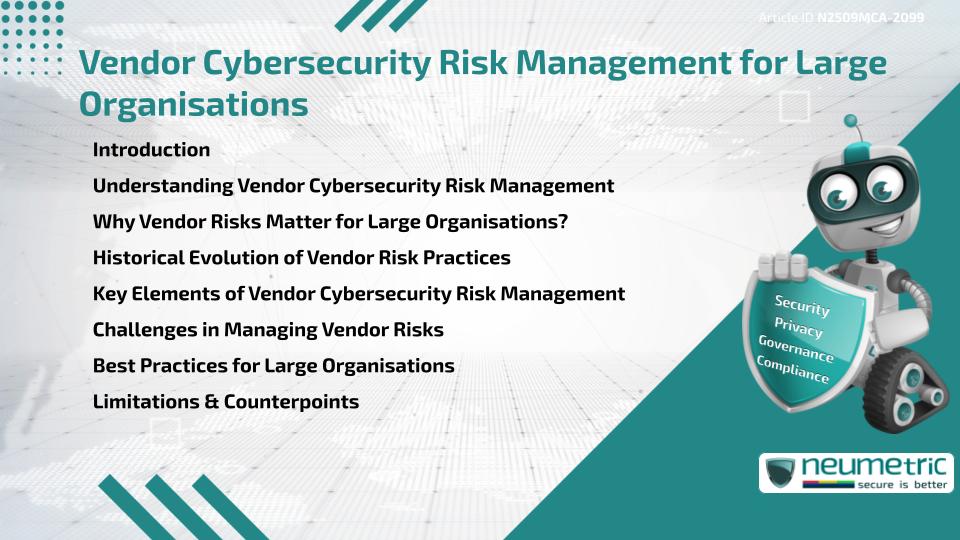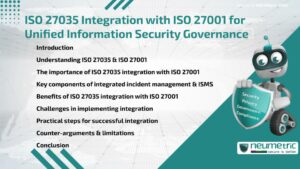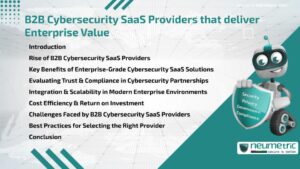Table of Contents
ToggleIntroduction
Vendor Cybersecurity Risk Management has become a critical priority for large organisations as they increasingly rely on Third Party Providers for essential services. This practice involves assessing, monitoring & mitigating Risks that arise when Vendors have access to Sensitive Data, Networks or Systems. For large organisations, a breach in a Vendor’s environment can lead to reputational harm, Financial losses & Regulatory penalties. This article explores the importance of Vendor Cybersecurity Risk Management, its evolution, core practices, challenges & best approaches for organisations aiming to secure their Supply chain & Vendor ecosystem.
Understanding Vendor Cybersecurity Risk Management
Vendor Cybersecurity Risk Management refers to the structured process of identifying, evaluating & controlling Risks posed by external service Providers & Suppliers. It ensures that Vendors handling data or connecting to enterprise systems uphold security standards that align with the organisation’s requirements. For example, Cloud Providers, Payment Processors & IT Support Contractors all represent possible entry points for Cyber Threats.
Why Vendor Risks Matter for Large Organisations?
Large organisations depend on a vast network of third parties to maintain operations. These include Software Developers, Logistics Providers & Communication Services. If even one Vendor has inadequate Security Measures, attackers may exploit this weak link to infiltrate the larger enterprise. The 2013 Retail Data Breach traced to a Vendor remains a notable example of such Vulnerability. Beyond data exposure, poor Vendor security can disrupt supply chains & diminish Customer Trust.
Historical Evolution of Vendor Risk Practices
Historically, Vendor Risk Management was treated primarily as a Financial or operational concern. Cybersecurity Risks gained attention in the early 2000s as companies digitised processes & adopted outsourcing models. Over time, regulations such as the General Data Protection Regulation [GDPR] in Europe & the Health Insurance Portability & Accountability Act [HIPAA] in the United States further emphasised the need for vendor oversight. Today, Cybersecurity is central to Vendor Governance strategies worldwide.
Key Elements of Vendor Cybersecurity Risk Management
Several components form the foundation of Vendor Cybersecurity Risk Management:
- Vendor Risk Assessments: Evaluating Vendors before & during contracts to verify Compliance with Security standards.
- Contractual Obligations: Embedding Security requirements, Data Protection clauses & Audit rights into contracts.
- Continuous Monitoring: Using tools & periodic reviews to detect changes in a Vendor’s Security posture.
- Incident Response Planning: Ensuring Vendors can coordinate with the organisation in the event of a breach.
- Vendor Tiering: Prioritising oversight of Vendors based on the sensitivity of data they access.
Challenges in Managing Vendor Risks
Managing Vendor Cybersecurity Risk Management comes with notable difficulties. Large organisations may engage with thousands of Vendors, making oversight resource-intensive. Additionally, gaining visibility into a vendor’s internal processes can be limited by contractual restrictions or lack of transparency. Cultural & geographic differences can also complicate expectations around security practices.
Best Practices for Large Organisations
To strengthen Vendor Cybersecurity Risk Management, large organisations can adopt the following practices:
- Establish a Centralised Vendor Risk Management Program.
- Require Vendors to undergo Cybersecurity Training & Certifications.
- Use Independent Audits & Penetration Testing to verify Controls.
- Apply Automated Tools to monitor Vendor Risks continuously.
- Foster open communication with Vendors to build long-term Trust.
Limitations & Counterpoints
While Vendor Cybersecurity Risk Management is vital, it is not without limitations. Overly stringent requirements may discourage smaller Vendors from working with large organisations. In addition, relying heavily on Third Party assessments may lead to blind spots if Vendors provide incomplete information. Striking the right balance between thorough oversight & operational flexibility is crucial.
Conclusion
Vendor Cybersecurity Risk Management has grown into a cornerstone of enterprise security strategy. By embedding Risk practices into procurement, contracts & ongoing monitoring, large organisations can better protect themselves from Third Party Threats. Though challenges & limitations exist, adopting a structured & proactive approach enhances resilience against evolving cyber Risks.
Takeaways
- Vendor Cybersecurity Risk Management protects large organisations from Third Party Threats.
- Historical regulations & digital transformation elevated Vendor oversight to a priority.
- Key practices include assessments, monitoring & contractual controls.
- Challenges include vendor scale, transparency & global complexities.
- Balanced approaches reduce Risks while maintaining Operational efficiency.
FAQ
What is Vendor Cybersecurity Risk Management?
Vendor Cybersecurity Risk Management is the process of assessing & mitigating security Risks that Vendors pose when accessing an organisation’s systems or data.
Why is Vendor Cybersecurity Risk Management important for large organisations?
It is important because a single weak Vendor can allow attackers to compromise Sensitive Systems, causing Financial & Reputational harm.
How do organisations evaluate vendor Risks?
Organisations conduct Risk Assessments, review Certifications, perform Audits & enforce Contractual Obligations with clear security requirements.
What challenges exist in Vendor Cybersecurity Risk Management?
Challenges include managing thousands of Vendors, limited visibility into vendor processes & balancing stringent controls with business needs.
What are Best Practices for Vendor Cybersecurity Risk Management?
Best Practices include Centralised Governance, Continuous Monitoring, Independent Audits & effective Incident Response Planning with Vendors.
Can Vendor Cybersecurity Risk Management prevent all breaches?
No, it reduces the Likelihood & Impact of breaches but cannot eliminate all Risks due to human error, evolving Threats & Vendor limitations.
How does Regulation influence Vendor Cybersecurity Risk Management?
Regulations such as GDPR & HIPAA require organisations to ensure that Vendors handling Sensitive Data follow strict security & Privacy standards.
Need help for Security, Privacy, Governance & VAPT?
Neumetric provides organisations the necessary help to achieve their Cybersecurity, Compliance, Governance, Privacy, Certifications & Pentesting needs.
Organisations & Businesses, specifically those which provide SaaS & AI Solutions in the Fintech, BFSI & other regulated sectors, usually need a Cybersecurity Partner for meeting & maintaining the ongoing Security & Privacy needs & requirements of their Enterprise Clients & Privacy conscious Customers.
SOC 2, ISO 27001, ISO 42001, NIST, HIPAA, HECVAT, EU GDPR are some of the Frameworks that are served by Fusion – a SaaS, multimodular, multitenant, centralised, automated, Cybersecurity & Compliance Management system.
Neumetric also provides Expert Services for technical security which covers VAPT for Web Applications, APIs, iOS & Android Mobile Apps, Security Testing for AWS & other Cloud Environments & Cloud Infrastructure & other similar scopes.
Reach out to us by Email or filling out the Contact Form…





